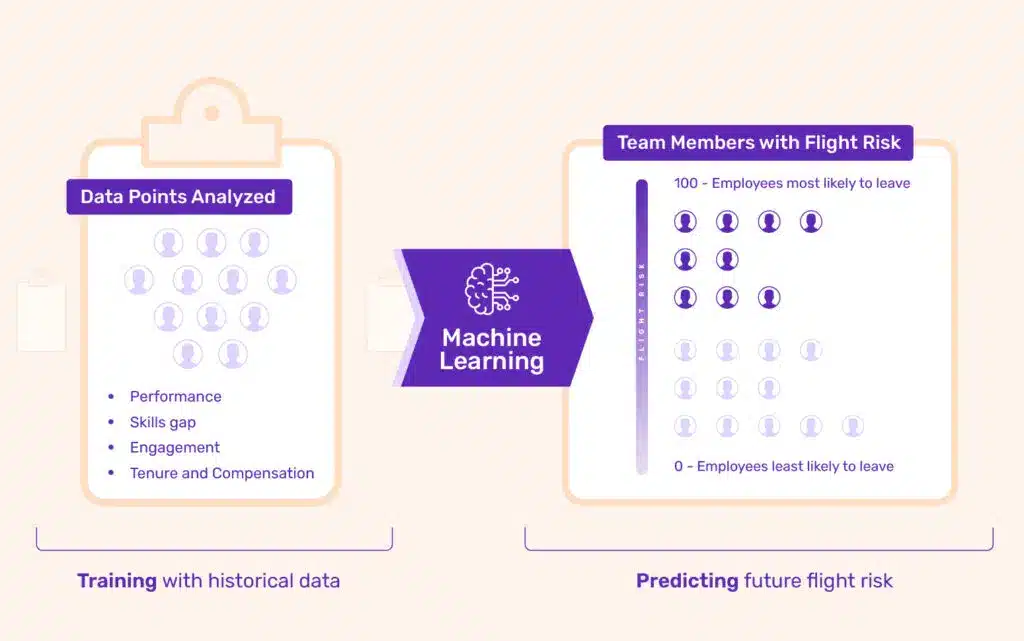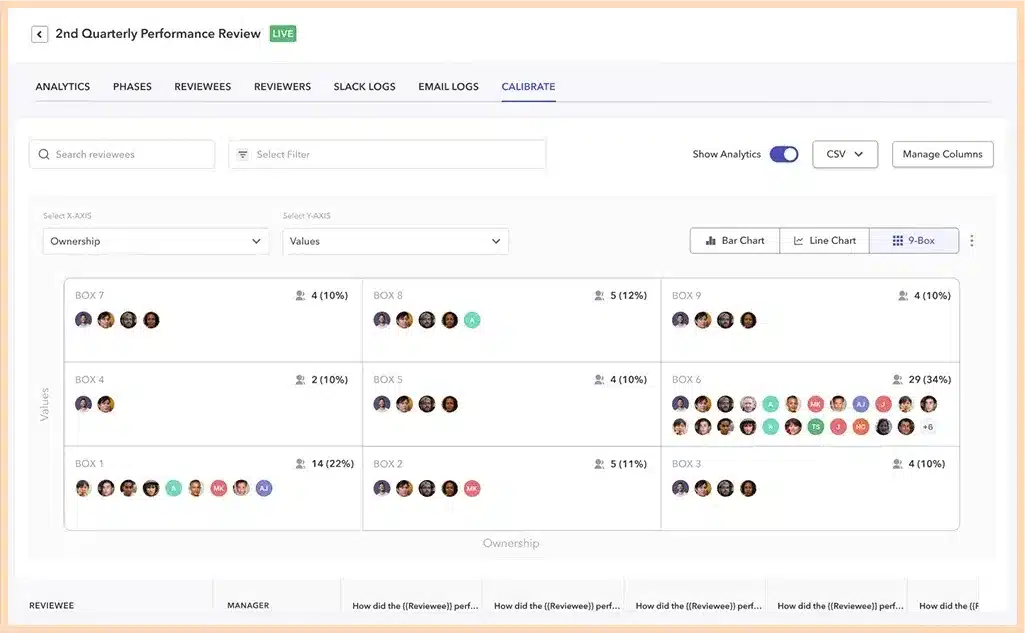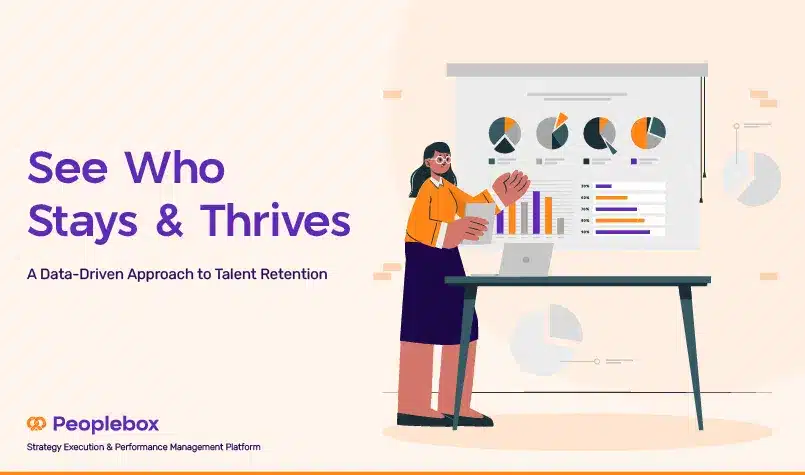59% of the workforce consists of quiet quitters, a term coined to describe disengaged employees who stuck to doing the bare minimum at work.
70 percent of employee turnover in 2022 in the US was voluntary, says the Department of Labor.
To put a number on it, around 4.2 million employees leave every month.
For business owners or anyone in the people business, these are expensive events.
As an HR leader, you have to work on effective retention strategies if you want to avoid dips in productivity and rushed external recruiting costs.
So how do you do it?
Using predictive HR analytics may just be the answer because it identifies employee issues before they even become a problem. Specifically, with predictive HR analytics, you can pinpoint:
- Employees at risk of leaving the company
- Future skill gaps and performance issues
- Employees who will be great performers
- Issues that affect employee engagement, etc
It brings all your all HR and business data together and influences your strategies for workforce planning, talent acquisition, employee engagement, and retention.
Let’s get into exactly what predictive HR analytics is, what the benefits are, and how you can get started with incorporating it into your strategies, along with insights and examples.

What is Predictive HR Analytics?
Predictive HR analytics is a technique that uses HR data analysis and statistical modeling to forecast future trends in your workforce.
Say, in the past, employee productivity dropped by 20% for a consistent period of 4 months before they handed in their resignations. This is historical data.
Predictive HR analytics processes this data and builds a predictive model. The model can look for similar drops in current employee productivity and conclude that, just like the employees losing productivity before, the current employees are at a higher risk of leaving.
Benefits of Using Predictive HR Analytics
Predictive HR analytics offers a lot more than predicting the specifics of employee turnover.
Reduce costs
Every employee who quits must be replaced, which is costly in terms of money and the time it takes to recruit, onboard, and train new employees. According to Gallup, the cost of replacing an employee ranges from half or twice their yearly salary.
Predictive workforce analytics can reduce turnover rates by helping you visualize future outcomes.
Increase productivity
Predictive HR analytics optimizes team performance by proactively identifying skill gaps and potential performance issues. This allows for targeted training and support, ensuring teams have the right capabilities and avoids disruptions caused by unexpected performance dips. By building well-rounded teams with complementary skillsets, collaboration improves and overall team efficiency is boosted.
Improve employer branding
Consistently high employee retention sends a signal out into the market — that your business is a great place to work, which is why people don’t want to leave. This may be a simplistic perspective, but in an age where employees are getting fired in large numbers and choosing to leave as well, making a name for yourself in terms of job security and employee well-being will attract better human capital.
How Can Predictive HR Analytics Help Retain Talent?
Let’s get into the specifics of where you can apply predictive HR analytics in your business, and what outcomes you can expect.
Identifying Flight Risk
The primary purpose of predictive HR analytics is to identify who is likely to leave — employees who are also known as flight risks. But how does it do this?
Predictive analytics analyzes several data points and uses machine learning to spot patterns that indicate a certain outcome —employees quitting.
HR predictive analytics platform analyses data points like:
- Performance: Employees who are consistently underperforming or suddenly go from performing really well to very poorly.
- Skills gap: Employees who have been stagnant in their roles, have not been allowed to grow, or whose skills are becoming obsolete.
- Engagement: Not engaging with team members
- Tenure and compensation: Employees who have worked with the company with no promotions or increase in annual salary.
These data points are fed into the model, which churns out a list of team members who match some or all of these criteria. They’re assigned a “flight risk score”, which tells you which ones to focus on first.

Actions Businesses can take
For example, if the model identifies a high-performing employee who had a sudden drop in productivity as a flight risk, you can reach out to understand their concerns. Depending on what they are, you can offer career development opportunities, or adjust their compensation to prevent them from leaving.
Understanding Employee Needs
Predictive HR analytics help you understand what motivates employees. It arms your HR team with data from engagement surveys, exit interviews, and performance reviews to pull in actionable insights about employee satisfaction. This information is then used to strategize how to address needs and improve employee turnover rates.
Let’s say your company conducts an annual engagement survey. From the survey, predictive HR extracts themes of dissatisfaction like lack of career growth and inadequate compensation.
With this insight, you can address these needs by:
- Starting a mentorship program that pairs junior employees with more experienced colleagues
- Offering training and workshops to help employees develop new skills
- Creating a clear career path that outlines opportunities for advancement within the department
Did you know? Peoplebox offers an efficient pulse survey feature that lets you assess what exactly your employees need.

Personalized Retention Strategies
Every employee has a different set of priorities, and therefore requires different interventions to stay engaged. For some, it could be making as much money as possible. For others, it could be work-life balance, or the opportunity to learn new skills.
Predictive HR analytics is a powerful tool in your tech stack that will help you address the key question in people operations: “What does my employee want?”. Let’s look at three kinds of employees that are likely to leave, and how to re-engage them:
High-potential employees with a skills gap: These employees are either at risk of losing their jobs because of obsolete skills, or have started realizing they’re not evolving in their roles. For example, a marketer who has mainly been involved in executing strategy for a long time may want to be involved in developing that strategy to influence business outcomes themselves.
Targeted development and mentorship programs will help them close that gap and advance their careers.
Disengaged employees: These employees are less invested in their jobs than before, and predictive HR analytics will help you understand why. From hereon, you can make changes that address the root cause of their disengagement. This could be to adjust their workload or improve communication with senior management.
Valuable employees considering leaving for better compensation: This kind of employee isn’t being paid enough given their expertise and expectations. The solution is simple, to adjust their compensation structure and benefits package.
Improving Work Culture
Predictive HR analytics can be used to improve general workplace culture, by recognizing data that does not fit into regular parameters. To break this down:
- The predictive HR analytics system measures the normal level of job satisfaction in the company, in the past few years.
- It looks for a pattern, has job satisfaction been going down for some departments and up for a few?
- It then predicts the future levels of job satisfaction according to these patterns to bring to your attention anything that might snowball into a bigger problem.
It can also look into the specifics of the situation— was this always the case? Or has a recent development changed things — maybe a new manager being brought in? An insight like this will tell you that you may need to train managers better or initiate team-building exercises to help the team get to know the people in charge better.
Additional Applications of Predictive Analytics For Human Resources
Now that we’ve tackled the main applications of predictive analytics for human resources, let’s look at two other applications it could help with:
Recruitment: Resumes are not always the best indicators of who the best hire is. Predictive analytics can identify key skills, experience, and personality traits that match open roles. You can leverage this to look for leadership traits in an application to find top talent, instead of sticking to a list of educational qualifications and previous employers.
Performance Management: Let’s reiterate that every individual is different. They have to be nurtured differently. Predictive HR analytics can segment individuals and teams according to how their performance should be optimized, and help you make better decisions as to how you should plan development for them.

Getting Started with Predictive People Analytics
The adoption rate for predictive modeling is low. Data analytics is not used very often to identify patterns, much less to predict patterns. According to research by SHRM, 4% of businesses use this technology. This is because it is considered to be an advanced and complicated technology.
With the right tool that can collect all the “signals”, people analytics becomes much simpler.

Here are the steps you can take to get started with implementing this strategy.
Decide on the Data Sources You Want to Use
Your first step is to gather all relevant employee data from your HRIS, payroll systems, performance reviews, and surveys. The more diverse your range of data is, the more context your predictive analytics model will have — giving you better insights in the long run.
Key metrics like performance reviews and engagement scores are vital datasets that you should be feeding into the system. Why?
- Performance reviews reveal employee productivity, strengths, weaknesses, and growth potential.
- Engagement scores can tell you how committed an employee is to the job at hand, and how satisfied they are with work.
Combining these two allows you to identify high-potential and dissatisfied employees at the same time.
Performance management platforms like Peoplebox, with their highly intuitive and customizable 9-box grid feature, let you easily identify high-performers from within the platform.

Clean and Organize Data
Remove all outdated information and ensure everything is in a consistent format. Ask yourself:
- Is this data consistent and clear?
- Are there any duplicates or errors that could warp results?
- Is the data structured in a way that can be easily analyzed?
Cleaning your present data makes sure the results you get from your analytics system are accurate and reliable.
Choose an Analytics Tool
You’ve got lots of data now, which means you need the right tool to process it. Choose a tool that is:
- Intuitive to use
- Easy to integrate with other software so you can import data easily
- Offers a wide variety of features so you have a centralized platform for multiple functionalities
- Has built-in analytics features to help you organize your insights about your workforce
Peoplebox checks all the points above. It is a trusted tool used by enterprises and startups equally, because:
- The user interface is simple and can be navigated by anyone, even a non-recruiter.
- Peoplebox supports several databases and SaaS applications, along with HRIS, ATS, CRM, and project management platforms. This means you can seamlessly collect data from all your sources without having to worry about clunky integrations or getting a third tool into the picture.
- It can identify trends with its built-in analytical capabilities, like measuring changes in skill gaps over time.
- It allows you to have a birds eye view of your entire workforce at a single glance.
Identify the most crucial business areas you want to tackle first
It is much more effective to address the most pressing concerns in your business than trying to implement an overall beneficial strategy.
You could use predictive analytics to elevate all the areas of your business eventually, but your first move should be to prioritize the areas costing you money or doing more poorly than others.
So identify your main challenges. What are they? Turnover? Productivity? If you’re unsure of where to start, ask yourself questions like:
- Which departments have the lowest productivity levels?
- What are the most common reasons for customer complaints?
- Which training programs have the lowest completion rates?
Conduct a Pilot Project
Going to deploy a big project based on insights from a brand-new system? If you have your qualms about that, smart small with a pilot project.
Identify a specific, manageable problem, use predictive HR analytics to extract insights, strategize, and implement changes.
Monitor the results closely to evaluate whether this approach is working for your business strategy.
If the pilot project has delivered results, you can gradually expand the reach of your predictive analytics initiatives.
Refine and communicate
No system is perfect from the start, Regardless of how clean your data is, or how many pilot projects you’ve tested, every system will eventually run into problems. Use these experiences to refine your approach, update your models and refine your data mining as needed.
With time, communicate the impact of predictive analytics to senior management and other relevant teams so the insights can be leveraged effectively. This will reinforce the value of the system, meaning more data will be collected and analyzed, and predictive HR analytics will find a permanent place in your retention strategies.
Key Considerations When Implementing Predictive HR Analytics
Now that you have a fair idea of how to get started with building a predictive HR analytics system, here are a few things to remember when you’re implementing your system.
- Data Quality: As we’ve pointed out, the accuracy, formatting, and relevancy of your data will affect your results and the quality of your insights.
- Ethical Implications: Since a lot of data is processed, with sophisticated systems garnering near-perfect insights, a lot is bound to be revealed about employees. Ensure the model is based on fair data, and guard privacy. Be transparent about how their data is used, and make getting consent mandatory.
- Transparency and Communication: If you’re going to use the predictive HR model to primarily find employees who want to leave, then convey this to them. Be clear about why their data is being used, and to what end. This may make the results slightly inaccurate in situations like surveys, but should not affect most of your data sources.
- Manager Training: Predictive analytics insights are only valuable if managers know how to interpret and act on them appropriately. Provide training for managers on:
- Understanding predictive analytics concepts and outputs
- Using insights to inform decisions and strategies
- Focus on Improvement: The ultimate goal of predictive HR analytics should be to drive positive change and improvement, not to punish or blame. Use insights to:
- Identify areas for improvement, employee development and support
- Optimize talent management strategies and HR processes
Leverage Peoplebox for People Data
Got a bunch of different surveys and performance reviews spread out over a few departments and years? Peoplebox has got you covered.
Peoplebox’s system is designed to be a central repository for your business needs. It pulls in and holds all your HR and business data to build actionable insights that you can use to drive strategic impact in your organization. Ready to be the change? Get started today.








